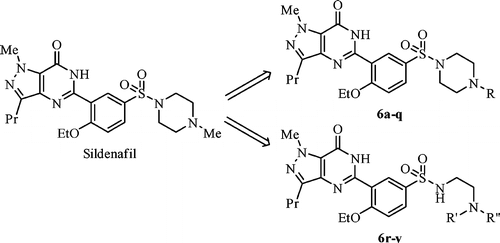Sildenafil and analogues
Abstract
The 5-[2-ethoxy-5-(4-methylpiperazin-1-ylsulfonyl)phenyl]-1-methyl-3-propyl-1,6-dihydro-7H-pyrazolo[4,3-d]pyrimidin-7-one, sildenafil, is a cGMP-specific phosphodiesterase-5 (PDE5) inhibitor used for penile erectile dysfunction. In the search for more potent and selective PDE5 inhibitors, new sildenafil analogues (6a−v), characterized by the presence on the sulfonyl group in the 5′ position of novel N-4-substituted piperazines or ethylenediamine moiety, were prepared by traditional and microwave-assisted synthesis and tested in rabbit isolated aorta and corpus cavernosum. Similarly to sildenafil, several analogues showed IC50 values in the nanomolar range. In the in vitro studies, all the tested compounds caused concentration-dependent relaxations in both rabbit isolated aorta and corpus cavernosum. All sildenafil analogues potentiated the nitric oxide-dependent vasodilation in endothelium-intact rabbit aorta. Compound 6f exhibited great pEC50 value in corpus cavernosum, and compounds 6r and 6u in isolated aorta were found as potent as sildenafil for inhibiting PDE5. Because several analogues were significantly more lipophilic than sildenafil, these compounds may offer a new lead for development of new sildenafil analogues.

